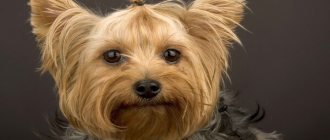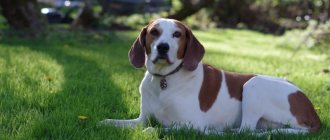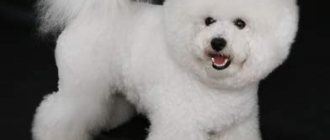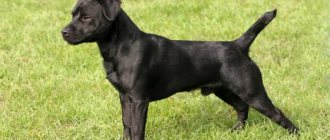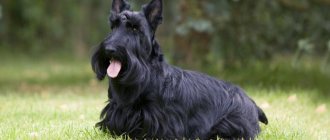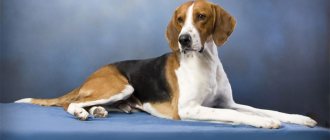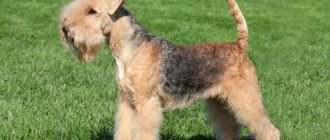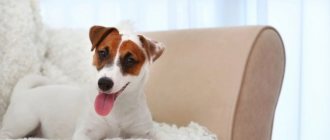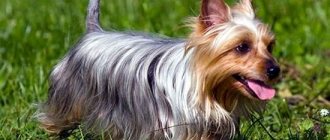- Pets
- >>
- Dog breeds
* Here is a photo of a typical representative of the Toy Fox Terrier dog breed . You can send us photos of your animals by email, and we will post them on the website. Don't forget to send your pet's name.
Other breed names:
American Toy Fox Terrier
Video
* We invite you to watch a video about the Toy Fox Terrier . In fact, in front of you is a playlist in which you can select and watch any of 20 videos about a given dog breed by simply clicking on the button in the upper right corner of the window. In addition, the material contains quite a lot of photos. By looking at them you can find out what a Toy Fox Terrier looks like.
In this article:
|
Rate the material!
[Total votes: 5 Average: 3.4]
History of the origin of toy fox terriers
The Smooth Fox Terrier was first recorded in the 1500s. This breed was developed and bred to help people while hunting. The dogs chased the foxes out of their holes. At that time, this breed did not have clear standards, because its representatives had completely different sizes. Some were tall and weighed about nine kilograms, while others rarely reached three kilograms in weight.
At that time, small, sleek fox terriers were more valuable. These are dogs with an inexhaustible source of energy. They were always ready for any adventure: defending a home, hunting rats or fighting a dog. Large representatives of the breed were less active. However, both small and large fox terriers were registered by the Kennel Club as one breed in 1912. Only twenty-four years later these dogs were separated.
Owners of the former began asking for the separation of small and large fox terriers in 1920. But these requests were not heard immediately. Only in 1936 did small fox terriers become a separate breed and received the name: “toy fox terrier”. The American Kennel Club officially recognized the breed even later - in 2003. Despite this, discussions about the size of such fox terriers took a long time.
Some breeders believed that the Toy Fox Terrier lacked height. Others tried to add the blood of other dogs, for example, Chihuahuas, to the breed. But for most owners of small fox terriers, these ideas were unacceptable. They didn't want to spoil the breed's gene pool. As a result, the OKS agreed with the latter and it was decided that the dogs should remain the same size. In 1960, the breed's stud book was closed.
History of the breed
The breed originated in the United States in the 1930s.
Its appearance was associated with the widespread popularity of circus performances at that time. The corpses traveled around the country, and small dogs had to perform one of the main tasks - to destroy rodents.
NOTE!
The basis was taken from the best representatives of Chihuahuas and smooth fox terriers (due to their relationship with the latter, the breed is also called toy fox). Therefore, the offspring never had serious defects then and now.
This breed was also an excellent hunting companion . The dogs were fast and agile, which made it possible to successfully catch or drive various small animals towards their owner.
Despite the fact that the breed existed for a long time, it did not receive worldwide recognition for a long time. It wasn't until 2003 that it was approved by the American Kennel Club.
Toy Fox Terrier - description of the breed
The Toy Fox Terrier has harmonious external characteristics:
- Small head;
- Muscular body;
- Almond-shaped eyes;
- Triangular ears;
- Slender limbs.
This American dog is quite small, but slender, agile and strong. Its height usually does not exceed thirty centimeters. He has a slender body with pronounced muscle relief. The Toy Fox Terrier weighs up to three kilograms. Despite its modest size, this animal is quite strong, has developed muscles, a straight back and a deep chest. The stomach is taut.
The head harmoniously complements the body - it is small and wedge-shaped. The animal's muzzle is elongated, narrowing towards the nose. The dog's bite is correct and scissor-shaped. The Fox Terrier's jaws are well developed, quite strong and grasping. It is not easy for prey to escape from them. The neck goes well with a small head. She is muscular and has a graceful curve. There is no dewlap at the neck.
Toy Fox Terriers have very beautiful eyes. They are medium in size and almond-shaped. The eye color of dogs of this breed may differ only slightly: from dark brown to hazel. The dog's eyes always sparkle and look interested. Triangular ears are a special feature of the breed. They are very similar to the ears of bats. To the touch, the animal's ears resemble a very thin sheet of wood.
Particular attention should be paid to the dog's limbs. In a real Toy Fox Terrier they are almost perfectly straight, slender and graceful. The dog has well-developed hips. The dog's tail is set high. From birth it is shortened. The fox's paws are oval in shape. The fingers are always tightly clenched into a ball. Representatives of this breed have very strong nails and well-developed paw pads.
Description of the breed
The American Fox is a small but well-built dog. Despite her physique, her bones are very well strengthened. In general, its appearance gives the impression of a light and graceful animal. Compared to other dwarf dogs, the physical characteristics of this breed are much more reliable. As for their size, they grow up to 25 – 28 cm, and weigh no more than 3 kg. The gender characteristic is weakly expressed, so it is quite difficult to determine the sex of the animal by eye.
The body is square, lean and well balanced. The height of the dog at the withers is approximately equal to its length.
The back is short but strong, flowing smoothly to a slightly widened groin. The chest is deep and voluminous, its incision is oval. The ribs grow beautifully curved, but not barrel-shaped. They reach up to the elbows of the front paws.
In general, the structure of the body is such that there is a clearly visible narrowing from the chest to the hip. The belly is tucked up and, in combination with the front of the animal, forms a gracefully curved line. The neck is long and perfectly set, dry and powerful with a proudly protruding scruff.
The head is small and short. When viewed from above, its wedge-shaped shape becomes noticeable. The skull is moderately wide and rounded. The transition from the forehead to the muzzle is clearly expressed, in contrast to the furrow.
The skin is elastic and fits well to the skull, there are almost no folds or wrinkles. Cheeks and cheekbones are lifted, the space under the eyes is perfectly filled. The muzzle itself is not sharp, but tapers towards a black nose, with small nostrils. The lips are thin and close-fitting, with a black edge. In general, the muzzle is light and beautiful, has no sharp features and is an undeniable advantage of the animal.
The eyes are small, but slightly protruding. Their color is as dark as possible. They stand close to each other, not planted very deep. The look is very mischievous and playful, and from a distance the eyes resemble a pair of amazing beads.
The ears are long, erect and thin. They grow in the shape of a slightly elongated isosceles triangle. They should not be docked under any circumstances; they always remain in their natural form. The teeth are white and strong, the incisors are lined up and when the mouth is closed they overlap each other in a scissor bite.
The forelimbs are straight and parallel, with well-defined angulations and strong bones. The shoulders are straight and the shoulder blades are slightly tilted back. The elbows are bent towards the tail and lean against the chest when moving.
The hindquarters are level and widely spaced. The hips are wide and covered with a network of developed muscles. The knees are well defined and have excellent angulations. The hock joints are flexible and well developed. The tail is set high and has a tucked structure. Usually stopped immediately behind the 3rd or 4th vertebra.
The coat is short, hard and shiny. In the area of the neck and shoulders it is slightly longer than in the rest of the body. It can be painted white with tan, black or red spots.
Popular colors of Toy Fox Terriers
The body of the American Toy Fox Terrier is densely covered with hair. The coat of this dog looks like satin - it is very shiny and smooth to the touch. This dog's coat is short, which helps it easily penetrate narrow fox holes when hunting. The coat is slightly longer only in the neck and shoulders. The thick cover reliably protects the animal’s thin but elastic skin from scratches and various injuries.
By the condition of the coat and skin, you can recognize a faulty breed. If a puppy has sagging skin, lack of elasticity or dull fur, then these are significant shortcomings of the breed. An unacceptable factor is wool with a wave. Such a puppy cannot belong to the Toy Fox Terrier breed and in the future he will not be allowed to participate in official shows or any competitions.
Toy Fox Terriers have a naturally harmonious coat color. The predominant color in it must be white. Several options are allowed for combining white with brown, black, black and tan, black and red at the same time. The most popular today are tri-colored puppies. In this case, the body is painted white with black spots and red markings on the face.
In second place in popularity is white and black and tan. These puppies have predominantly black hair on their heads. A prerequisite is the presence of tan spots in the area of the jaws, eyebrows and cheekbones. White may be present as spots on the lower part of the muzzle. Puppies with a white-brown coat color are bought a little less often. Brown hair should predominate on their head.
About the Toy Fox Terrier breed
TOY FOX TERRIER
COUNTRY OF ORIGIN: United States of America.
DATE OF ORIGINAL STANDARD: 07/08/2003
USE: Decorative terrier, companion.
FCI CLASSIFICATION : Group 9. Decorative dogs, companions. Not recognized by the FCI.
GENERAL FORM:
The Toy Fox Terrier is a well-balanced, small, athletic-looking dog that exhibits equal parts grace and agility, as well as strength and tirelessness. His flexible, muscular body has smooth, elegant contours, which creates the impression of effortless movements and endless endurance. By nature, the dog is well-groomed, proud, active and always on the alert. The bones should be strong, but not excessively strong, and always in proportion to the size of the dog. Overall balance is very important. The characteristic features of the breed are: an elegant head, a short shiny coat of a dominant white color combined with a predominantly fully colored head, a high-set, short tail.
BEHAVIOR AND TEMPERAMENT:
The Toy Fox Terrier does have characteristics of both toy dogs and terriers. The traits of both influence the personality and character of the Toy Fox Terrier. As a terrier, the Toy Fox Terrier exhibits keen intelligence, courage, and liveliness. Like a toy, it is characterized by its miniature size and the ability to give its boundless, unfailing love to its owner. The Toy Fox Terrier is smart, attentive and friendly, devoted to its owners. He quickly learns new commands, strives to please and adapts to almost any situation. Toy Fox Terriers, like other terriers, are cool-blooded, energetic, determined, and not easily intimidated. This is a very lively, playful and cheerful little dog. The absence of typical terrier properties and characteristics in any individual is regarded as a defect or defect, depending on the degree of severity.
HEAD:
Elegant, balanced, without signs of coarseness. The expression is intelligent, attentive, insightful and interested.
Skull: Moderately wide, slightly rounded and slightly wedge-shaped. Moderate transition from forehead to muzzle, quite noticeable. When viewed from the front, the head gradually widens from the nose to the base of the ears. The distance from the nose to the transition from the forehead to the muzzle is equal to the distance from the stop to the occipital protuberance. The cheekbones are flat and muscular; The under eye area is well filled.
Muzzle: Strong rather than dry, in proportion to the head as a whole, the lines of the forehead and muzzle being parallel.
Nose: Black, with the exception of brown-colored dogs, which have a nose that matches the brown spots.
Lips: thin, tightly fitting.
Teeth: A full set of strong white teeth with a scissor bite is preferred. Loss of teeth is not considered a defect if the bite can be determined to be correct.
Eyes: Clear, shiny and dark, including the edges of the eyelids, with the exception of brown-colored dogs, whose eye rims should match the brown spots. The eyes are round, slightly convex, but not bulging, with a pleasant, intelligent expression. They are well set on the sides, but not in an oblique cut, with close-fitting eyelids.
Ears: erect, pointed, triangular in shape, set high and close together, but never touching. The size of the ears is proportional to the head and body.
NECK:
Well set on, carried proudly with a slightly convex nape, gracefully arched, dry, muscular, without dewlap. It is proportional to the head and body, gradually expanding, smoothly turning into the shoulders. The length of the neck is approximately equal to the length of the head. The topline is level both when standing and when moving.
FRAME:
Balanced and slightly tapering from the ribs to the loin.
Topline: With pronounced withers, straight, horizontal and muscular. Short and strong in the loin.
Croup: Level with the topline and well rounded.
Chest: Deep and muscular, with well sprung ribs. The chest reaches deep to the elbows. The front part of the chest is well developed.
Hemline: Moderately toned, emphasizing grace and elegance.
TAIL:
Set on high, carried erect, in proportion to the size of the dog. The tail is docked at the level of the third or fourth vertebra. An undocked tail is not penalized.
LIMBS
FORE LIMBS:
Viewed from the front, straight and parallel. The angulations of the forelimbs are well defined.
Shoulders: set firmly, with developed, but not too much, muscles.
Shoulder blades: Well sloping back, smoothly moving from neck to back.
Elbows: close to the chest and directed straight back.
Pasterns: Strong and straight, but at the same time flexible.
Paws: small, oval, directed forward, without splay or clubfoot. The fingers are strong, arched, balled, with thick pads.
HINDQUARTERS:
When viewed from behind, straight and parallel. The angles of the hind limbs are well defined.
Thighs and shins: strong, muscular, of good length.
Stifles: Clearly defined, well angulated.
Hock joints: strong.
Hocks: Short and straight. Dewclaws should be removed.
SHIRT
COAT: short, shiny, silky, good structure, soft to the touch. The coat is slightly longer around the neck, covering the body evenly.
COLOR: Spotted - dominant white color combined with a predominantly fully colored head.
Tricolor.
Predominantly black head with distinct tan on cheekbones, jaws and above the eyes. The body is more than 50% white, with or without black spots.
White with brown spots and the obligatory tan on the head (tri-color)
The head is predominantly brown with distinct tan on the cheekbones, jaws and above the eyes. The body is more than 50% white, with or without brown spots.
White with red spots (two-tone)
Predominantly red head. The body is more than 50% white, with or without red spots.
White with black spots (two-tone)
Predominantly black head. The body is more than 50% white, with or without black spots.
Colors should be rich and pure. A white mark is acceptable, but it should not touch the eyes or ears. Pure white is preferred, but a small amount of speckling is not a reason for derating. In black-headed tricolor dogs, the spots on the body should be black. Brown-headed tricolor dogs should have brown spots on their body. Both tri-colors may have slight tan along the chest and under the tail patches, similar to the normal bi-color pattern.
SIZE:
21.5 - 29 cm (8.5 - 11.5 inches), preferably 23 - 28 cm (9 - 11 inches). The Toy Fox Terrier has a square format, when the height at the withers is approximately equal to the oblique length of the body. In this case, height is measured from the withers to the ground, and the oblique length of the body is measured from the protrusion of the shoulder-scapular joint to the ischial tuberosity. Let's assume a slightly more extended format for females.
MOVEMENTS:
free, smooth, with good reach and strong push. The topline remains straight and the head and tail are held erect when moving.
DEFECTS:
Any deviation from the above points is regarded as a defect or defect, depending on the degree of severity.
- The head is apple-shaped.
- Markings that extend below the elbow or hock, excluding the markings.
- Prancing step
DISQUALIFYING FAULTS:
- Aggressiveness or cowardice. — Any dog below 21.5 cm and above 29 cm. — Not erect ears in a dog older than six months — Light-colored nose. — Overshot, jaw distortion, underbite more than 3 mm. - White blaze extending to the eyes or ears. — Any color other than that provided by the standard.
Dogs with physical or behavioral abnormalities are disqualified.
N. B. Any male dog should have two apparently normal testes, completely descended into the scrotum.
Standard Approved by the Presidium of the RKF on December 27, 2011 for examination on the territory of the Russian Federation.
Character and habits of toy fox terriers
It is quite difficult to find a smarter dog than a toy fox terrier. Although this is a small, but smart and quick-witted dog. It has the appearance of an ornamental breed, but the intelligence and courage of a huge dog. Representatives of this breed have a light, cheerful disposition. This dog almost never gets bored and is never in a bad mood. Even when feeling unwell, the animal will remain good-natured.
The Toy Fox Terrier is a family dog. She is devoted to her owner and skillfully finds a common language with other family members. These dogs get along great with children. However, with very tiny children, problems can sometimes arise. This dog will not tolerate discomfort or abuse. If the baby accidentally hurts the pet, it may snap back and even bite.
Most representatives of the Toy Fox Terrier breed have an easy-going, calm character. However, there are exceptions - impulsive and stubborn puppies. If you come across one, don't despair. These negative traits can easily be corrected by early socialization and proper upbringing. The puppy must know who is boss in the house. Then he will give up his attempts to claim leadership and begin to obey.
Another character trait of Toy Fox Terriers is cockiness. This is not their best quality. These little dogs often get into conflicts with other animals. At the same time, they are not worried about the size of their opponent. They will be eager to fight even with a very large dog. The owner of a fox terrier should take this fact into account when going out for a walk with him. Foxes also do not get along well with cats and birds.
Character of the American Toy Fox Terrier
All representatives of this breed are very nimble, energetic dogs. Such dogs are very smart, inquisitive, and therefore attentive to any details in the environment. They are considered to be much smarter than other terriers.
The American Toy Fox Terrier masters the skills and tricks taught to him well. There are no problems with him during the training process. Moreover, active actions and training are simply necessary for them. Otherwise, their stupid energy turns them into a source of danger. Such dogs become mischievous and fussy.
Favorite activities include long walks and games. So that they can jump and run around to their heart's content, it is recommended to take them for walks in special enclosures.
Ideal for fitting into a large family with adult children or elderly people. It is difficult to find a common language with young children.
The breed retains the guard dog instinct. In case of danger, they take a stance. Capable of protecting the owner's personal property.
Despite their small size, dogs of this breed are very hardy. They are not afraid of long walks. In domestic conditions, toy fox terriers are not pretentious, but they require attention from their owners. They also do not like to be in the company of dogs of other breeds.
In general, the American Toy Fox Terrier has a tendency to lead, so it will try to dominate. If you don’t show who’s boss, very soon the owners will “dance to his tune.” For the same reason, they often do not get along with other pets, which sometimes even need to be abandoned.
Features of care
The American Toy Fox Terrier does not cause problems with the organization of care. The short coat requires that it be given shine, which is achieved through feeding and bathing.
Some breeders use dry shampoo. The fur should be combed with a stiff brush. It is worth checking your ears regularly, removing dirt if necessary.
The diet of dogs of this breed is quite limited. They do not require much food compared to other miniature dogs. To ensure that American Toy Fox Terrier puppies eat properly, you need to find out how the breeders fed them. At first, maintaining the same pattern will allow them to adapt more successfully to new conditions.
If the dog is given enough time, this little guy can be an excellent dog for an urban environment.
Interesting facts about Toy Fox Terriers
Despite the fact that Toy Fox Terriers were very rarely used for hunting, these animals did not lose their skills and instincts at all. Such a pet will definitely give chase to a cat, bird or rodent if it sees it on the street. It is better to walk the toy fox terrier on a leash if you do not want to then search for the dog throughout the area. Also, you should not house this pet with small pets.
Most Toy Fox Terriers are easy to train. They love to train, quickly learn commands, and show good results. But there is always an exception - stubborn and lazy puppies. The latter cannot be fought with aggression. The toy fox terrier needs to be interested. For example, create training for him in the form of a game. Then the pet will happily start training.
Toy Fox Terriers are wonderful companions. They can accompany their owner everywhere - on any journey. Due to its small size, such a dog is not prohibited from being taken on a plane or train or placed in a hotel room. The most important thing is to follow one rule - the toy fox terrier in a public place must be in a special carrying bag or in the arms of its owner.
Representatives of the Toy Fox Terrier breed are very susceptible to cold and drafts. Taking this into account, you should not place your dog’s bed near a window or door. Foxes can also catch a cold instantly if they go out for a walk with their owner in windy and rainy weather. You should not walk with this pet in the rain, and in winter it must be dressed in special warm dog clothes. She will be able to protect the toy fox terrier from colds.
Pros and cons of Toy Fox Terriers
Advantages of Fox Terriers:
- Aesthetic appearance;
- Miniature sizes;
- Ease of caring for the dog;
- Good nature;
- Cheerful disposition.
Disadvantages of Fox Terriers:
- Stubbornness;
- Skeletal fragility;
- Excessive activity.
Toy Fox Terriers make excellent family pets. Previously, their main value lay in their excellent hunting skills. These dogs accompanied and helped hunters in catching small wild animals. Today, toy fox terriers have become pets and companion dogs. And they cope with this role perfectly! They adore their owner and know how to get along with children and the elderly.
Dog breeders really appreciate their cute, attractive appearance. These little dogs look touching. In addition, its miniature dimensions make this dog more mobile and convenient. She can easily live even in a small apartment. The Toy Fox Terrier does not require complex, expensive care. This is a fairly clean dog that does not require any special hygiene procedures.
The advantage of the breed is its cheerful, kind disposition. These dogs know how to cheer up, they love to play and almost never feel sad. Toy Fox Terriers are kind and quickly become attached to people. They adore their family and are always ready to defend it. But, of course, due to its modest dimensions, such a dog is no guard or protector. This must be taken into account when buying a puppy.
The disadvantage of the breed is the stubbornness that some puppies express during training. This can be dealt with by conducting classes in a playful way. Another disadvantage is the fragility of the skeleton. These dogs can receive various injuries and fractures. They should not jump from great heights. Excessive activity is another disadvantage of that Fox. Dogs require a lot of attention and do not like to sit still.
Dog character
The Small American Toy Terrier is a friendly and active dog. It is often used as an assistant for deaf people. The dog notifies its owner about the bell on the front door or by telephone. The toy terrier is an excellent companion for children with psychological problems; it helps them adapt to society and becomes a play partner. Here are the main character traits of a dog:
- fearlessness;
- self confidence;
- friendliness;
- devotion to the owner;
- good attitude towards children;
- activity;
- intelligence.
The American Toy Terrier is suitable for families with children; it plays well with them, and is able to protect them in critical situations. The dog finds a common language with other animals, gets along with cats, rabbits, hamsters and birds. The only animals towards which a Toy Terrier shows aggression are dogs of its own gender. An active and inquisitive dog will not let anyone get bored. He will examine the whole house, and if he is poorly trained, he will turn it upside down.
The toy terrier does not like to be left alone, he needs company. In the absence of his owners, he barks, plays pranks, and sometimes becomes depressed. The dog senses the owner's mood. If he is in a good mood, she plays and is active in every possible way. When the owner comes home tired, the mini dog happily lies next to him on the sofa and does not get bored. The docile, playful nature has made dogs of this breed popular; photos and videos of cute doggies are spreading with incredible speed.
Breeding Toy Fox Terriers
Breeding Toy Fox Terriers is a labor-intensive and responsible process. It requires a lot of physical effort and material costs. However, this is quite a profitable business, because there is a huge demand for miniature toy fox terriers in our country. These little dogs are especially popular among girls. They are attracted by his cute and aesthetically attractive appearance, kind disposition and irrepressible energy.
In order for a female Toy Fox Terrier to successfully reproduce, she must be strong and weigh at least two kilograms. She should have a straight back, a voluminous chest, and strong bones. When choosing a female, her color, height, and character are important. Heredity should also not be overlooked. You need to thoroughly study the pedigree, understand what problems the dog’s closest relatives had.
Next you should look for a manufacturer - a male. The dog must fully meet the breed standards, have good heredity and good health. The male's height should not be large. You need to choose a small manufacturer. Then it will be easier for the bitch to bear and give birth to puppies. If this is not the first mating for a male dog, it is advisable to look at previous puppies and find out what problems arose.
A bitch should not become pregnant or give birth before her 15th month. Until this age, the dog has not yet grown stronger and its body has not been fully formed. Before breeding, both dogs should be taken to a veterinarian for a preventive examination and tests. If everything is in order with the Toy Fox Terriers, you can get down to business. Mating should be carried out in the dog's territory. After the first time, you should definitely arrange a second meeting.
Caring for Toy Fox Terriers
Unlike many other four-legged animals, the Toy Fox Terrier needs apartment living conditions. Such a dog cannot exist on the street or in a booth. It is sensitive to cold, drafts and heat. An apartment for a Fox does not have to be large. A dog can live even in a small one-room apartment, but on the condition that the owner walks it every day and exercises with it in the fresh air.
In appearance, Toy Fox Terriers are very reminiscent of decorative dogs that constantly need care. However, it is not. Fox Terriers are not picky.
Caring for them should include standard procedures:
- The washing up;
- Combing;
- Cleaning eyes, ears, teeth;
- Vaccination.
The dog's coat is smooth and thick. It is advisable to comb it daily with a special mitten. This will help get rid of “dead” hairs in a timely manner and stimulate the skin. There is no need to wash this dog often. You only need to wash your pet's paws every day after walking outside. The dog should be completely bathed as needed and only using a special dog shampoo.
In order for the coat to remain shiny and healthy, you need to choose the right diet for the Toy Fox Terrier. It must be balanced with all vitamins and microelements. An important part of caring for your dog is cleaning the eyes and ears. This must be done as soon as it gets dirty. You can usually clean your eyes and ears with warm water or a special lotion that can be purchased at a veterinary pharmacy.
If you do not allow dirt to accumulate in the eyes and ears, then your pet will not know what inflammatory processes are. The Toy Fox Terrier also needs periodic teeth cleaning. This should be done several times a week with a special brush or silicone attachment. Brushing will prevent the formation of tartar. In addition to brushing, you can give your pet dental treats.
Dog care
The American Toy Terrier does not require special care. He is easy to train, puppies already at 1.5-2 months ask to go outside to use the toilet. You need to walk your dog several times a day, only on a leash. If you release a toy terrier in a crowded place, you will have to look for it for a long time. During a walk, the dog often gives the signal itself when it wants to go home.
In cold weather, the dog should be dressed for walks, since the American Toy Terrier is a short-haired dog. His paws are especially cold. Buy or sew a jacket, sweater, blanket for the fall. In winter, the Toy Terrier is dressed in overalls and boots. If you ignore these recommendations, your dog will catch a cold or contract pneumonia. They buy clothes online from a photo or in a pet store, sew them themselves or to order.
The breed's coat is short and hardly sheds, so people who are prone to allergies are recommended to own dogs. No special coat care is required. It is enough to bathe the dog once every two weeks; you can use dry shampoos for washing. Veterinarians recommend brushing Toy Terriers' teeth 1-2 times a week, as they are prone to the formation of plaque, stones and caries.
Diet of Toy Fox Terriers
The undoubted advantage of the American Toy Fox Terrier breed is its miniature size. This dog eats little, which is very economical. You should choose the diet and type of food for your pet based on several nuances: the dog’s age, its health characteristics, veterinarian recommendations, and the owner’s personal preferences. There are two ways of feeding: natural food and purchased industrial feed.
Most breeders and veterinarians recommend feeding Toy Fox Terriers commercial food. It is convenient and completely suitable for this breed of dog. Industrial food, the class of which is not lower than premium, contains all the necessary elements for the body of miniature dogs. There are different types of food, and a veterinarian or breeder can help you choose the ideal one.
If there is no desire or opportunity to buy good industrial food for your pet, then you can switch it to natural food. However, natural nutrition does not involve feeding the dog from the table. The Toy Fox Terrier should not be given food that people are used to eating. These animals cannot eat sweet, salty or smoked foods. The menu for the dog must be developed individually.
The Toy Fox Terrier's diet should include the following foods: quail eggs, sea fish, kefir, low-fat cottage cheese, chicken yolks, fruits, vegetables, seaweed, porridge. All foods can be given either raw or cooked. They should not be seasoned, salted or fried. The pet's food should be as dietary as possible. Additionally, you need to purchase vitamins.
Feeding the dog
The American Toy Terrier is unpretentious when it comes to food. He is fed both natural food and prepared food. Natural feeding should be balanced and include cereals, vegetables and meat. Dogs of this breed are often allergic to wheat, so it is recommended to give rice, buckwheat, and oatmeal as grains. Dogs should not eat pork, fatty lamb, or tubular bones. By-products should be well boiled. They are given no more than 1-2 times a week.
Dry food for a toy terrier (as for any other dog) is bought no lower than premium class. Their prices are higher, but they will keep your dog healthy. Canned food diversifies the diet, but is not the main food for a dog. When you buy a puppy, ask the breeder what he ate. Stick to the same type of feeding at first. New foods or feeds are introduced gradually.
Diseases and health problems
The Toy Fox Terrier is a small breed of dog, but quite strong. These dogs can live for about fifteen years if they are properly cared for. The secret to longevity is vaccinations, moderate to constant exercise, a balanced diet and careful monitoring of your health. As you can see, a lot will depend on the owner of the pet.
Despite their naturally good health, these miniature dogs have their “weak” points. Thus, the weak point of fox terriers is their fragile skeleton. These dogs should not jump from great heights. They can break their legs. Another feature of the breed is its susceptibility to cold and drafts. Toy Fox Terriers can often suffer from colds. They need to be dressed warmly.
Many Toy Fox Terrier puppies are quite sensitive to food and medications. They suffer from allergies, which can manifest themselves simply as skin irritation, or can cause suffocation in the animal. In this case, treatment should consist of completely eliminating the allergen from the life of the pet. If this is not possible, then constant use of antiallergic drugs will be required.
Also, toy fox terriers may experience various ailments of the digestive tract and stomach. You cannot experiment with this dog's diet. It should be balanced, low-fat and dietary. To avoid problems with nutrition, you need to consult a doctor. Less commonly, puppies are diagnosed with eye diseases of varying severity. Some diseases lead to blindness of the animal.
How to care for an American Hairless Terrier?
Many people who are thinking about purchasing a hairless dog are stopped by possible difficulties in grooming. In fact, keeping AGT is not particularly difficult, but the differences from dogs with fur are so obvious that they cannot be missed.
The first thing the owner of an American Hairless Terrier should know is that the dog needs clothes. In the cold season, this can be a sweater, fleece overalls, in the summer - a light cotton outfit that protects the dog’s skin from the sun’s rays. Like all hairless animals, the hairless terrier not only freezes and suffers from wind and rain, but is also capable of getting sunburned on a cloudless summer day. The lighter the dog, the worse the sunburn for it. By the way, owners of American Hairless Terriers often apply children's sunscreen with a high SPF level to their animals.
AGT should have its own wardrobe for any weather
Since clothing protects the animal’s skin not only from temperature effects, but also from dirt, the hairless terrier will have to be washed as it gets dirty. The animal does not have hair that could suffer from private washing, so AHT water procedures can be carried out at least every week. Moreover, the skin of these dogs is endowed with excellent regenerative properties - scratches and damage heal in just a couple of days. It is important not to use human shampoos or regular soap - hairless terriers need to purchase special cosmetics designed for hairless animals. Such shampoos do not dry out the dog’s skin and do not cause itching or discomfort.
Shampoo for hairless breeds
It is curious that fleas and other parasites do not live on the skin of American Hairless Terriers. The fact is that the absence of fur does not allow insects to hide, so AGT treatment can only be carried out with regard to ticks. We must not forget about the prevention of helminthiasis, and, like any other dog, feed the terrier an anthelmintic drug once a quarter.
The animal also needs other standard procedures: regular vaccinations, nail trimming, teeth brushing
Hypoallergenicity of the American Hairless Terrier
There is an opinion that hairless terriers are suitable for people suffering from an allergic reaction to “wool” breeds. This statement is partly true, since AGTs have unique properties of the skin. The skin of American Hairless Terriers has a special structure - there is a fatty layer on its surface that retains dead skin particles and dandruff. When washed, these particles are washed off without a trace, allowing people with allergies to the hair and skin secretions of dogs to own an American Hairless Terrier. The bonus of a hairless dog is that fur will not fly around the apartment.
The Hairless American Terrier has a unique skin structure and is a lower source of allergens
But, like any dog, the American Hairless Terrier leaves behind traces of saliva and secretions, which may not be accepted by the immune system of allergy sufferers and recognized as antigens. Accordingly, the breed cannot be called hypoallergenic in the full sense of the word. But these dogs give people who suffer from certain types of allergic reactions a chance to find a four-legged friend. In order for a person to understand whether he has a reaction to AHT, you can come to visit a puppy breeder and communicate with the animals, assessing the body’s response.
Table. Advantages and disadvantages of the breed
| Pros of owning a hairless terrier | Cons of owning a hairless terrier |
| The compact size allows the dog to live comfortably even in a small apartment | The dog must be dressed, choosing clothes for each season. |
| Due to the characteristics of the dog’s skin, the dog is less allergic | Skin care requires attention from the owner (use of sunscreen, special shampoo) |
| No hair during shedding, no need to wash for a long time after walks | The dog is not comfortable outside in the cold season; long walks are not feasible |
| Calm but friendly character, easy to learn, lack of aggression | The high cost of a puppy - prices for hairless terriers start from 40 thousand rubles |
American Hairless Terrier Health
AGT is a young breed, the genetic code of which has not been fully studied. However, there have been more than one generation of these dogs in Russia, and breeders assure that hairless terriers are not predisposed to any diseases. The main weakness is the animal’s delicate skin, which is not protected from external factors.
Maintain your dental hygiene
Another weak point of hairless terriers is the oral cavity. The owner must carefully monitor the dog’s dental hygiene, regularly brush them using a specialized toothpaste, and also provide the pet with edible toys for self-cleaning. The fact is that representatives of this breed are prone to gum inflammation and the formation of tartar. Otherwise, hairless terriers are strong dogs with excellent immunity.

